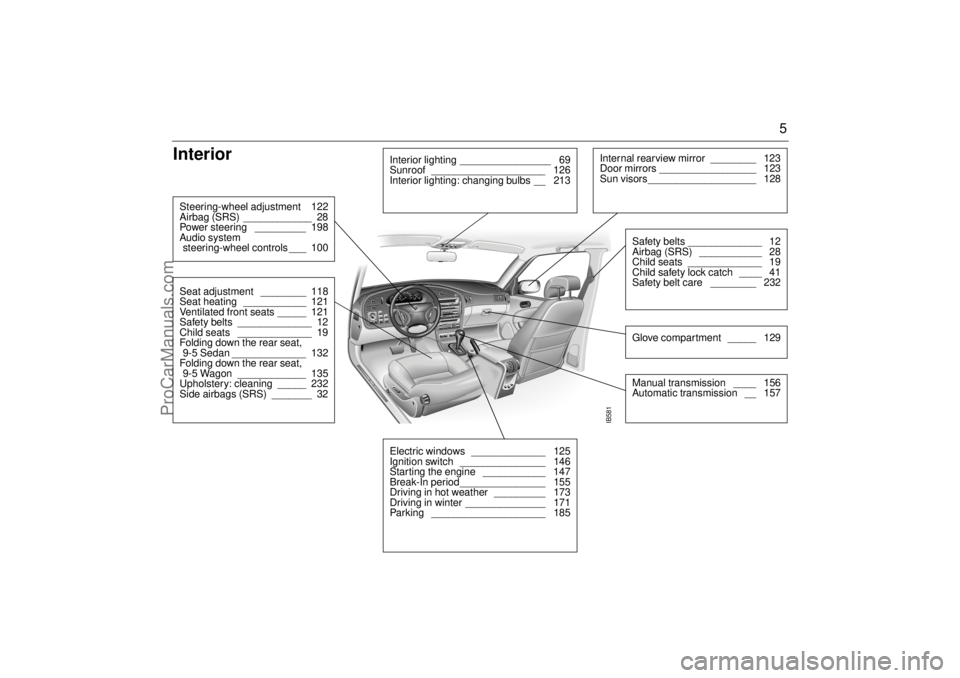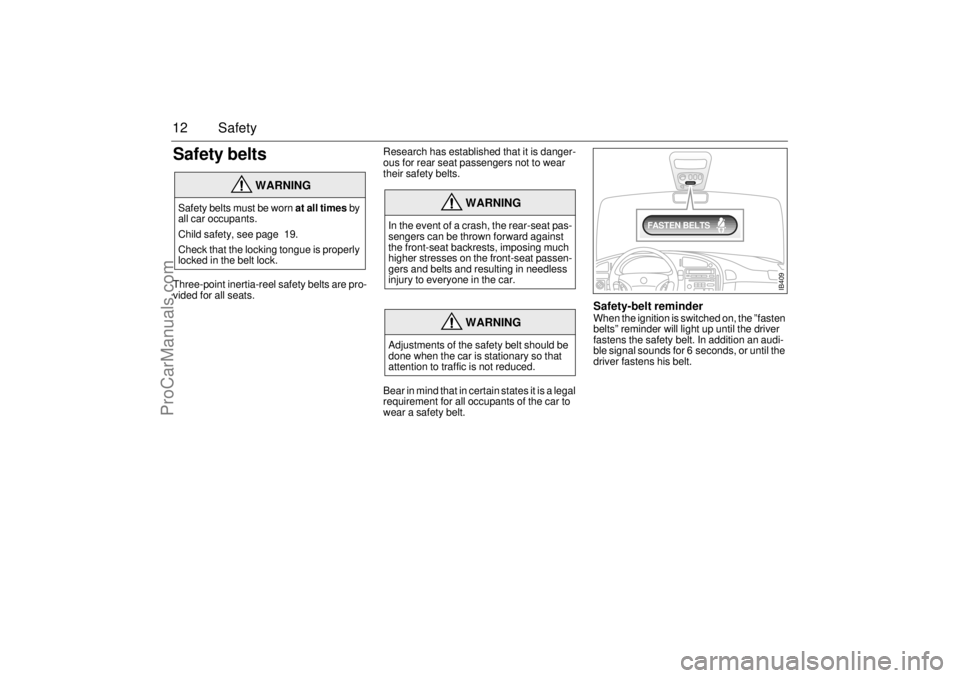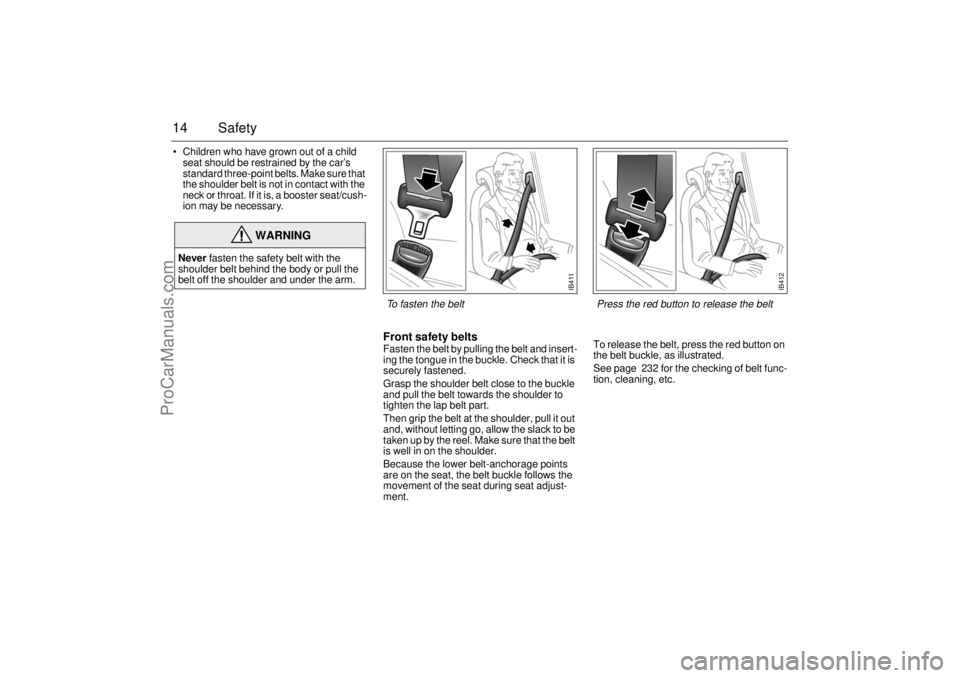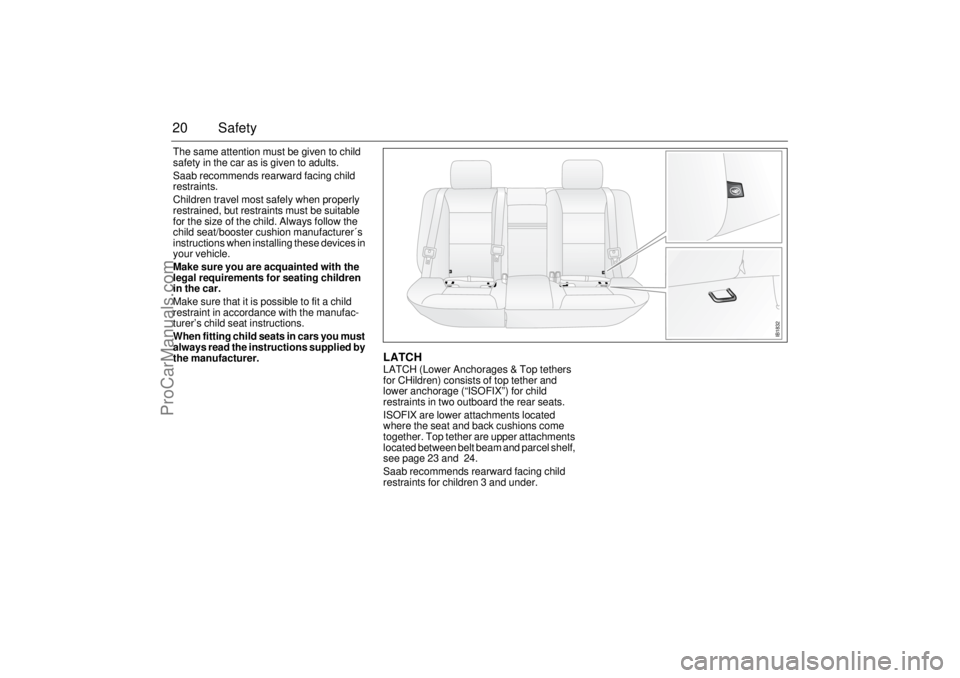child seat SAAB 9-5 2002 Owners Manual
[x] Cancel search | Manufacturer: SAAB, Model Year: 2002, Model line: 9-5, Model: SAAB 9-5 2002Pages: 272, PDF Size: 16.26 MB
Page 4 of 272

4Exterior
IB1736
Roof-rack load _______________ 176
Mounting holes for roof rack ____ 176
Maximum loads ______________ 248
Rearview mirrors _____________ 123
Hood ______________________ 188
Engine compartment: washing __ 233
Central lock ____________ 38
Interior locking buttons ____ 40
Child safety lock catch ____ 41
Trunk/tailgate lid lock _____ 41
Car alarm (anti-theft alarm) 43Front lights _____________ 65
Headlight switch _________ 65
High/low beam
control stalk ____________ 65
Turn signal &
lane change indicators ___ 67
Headlight washers _______ 70
Changing bulbs ________ 204
Fuel gauge __________________ 57
Fuel filler flap ________________ 152
Refueling ___________________ 152
Fuel economy _______________ 170
Fuel grade __________________ 250
Economical motoring __________ 170
Tire pressure ___________ back cover
Wheel and tire specifications ____ 256
Brakes and braking ___________ 165
Winter driving ________________ 171
Wheels and tires _____________ 222
Wheel changing ______________ 227
Spare wheel _________________ 179
Luggage compartment _________ 132
Folding down the rear seat,
9-5 Sedan ___________________ 132
Folding down the rear seat,
9-5 Wagon __________________ 135
Trunk _______________________ 132
Tool kit ______________________ 142
Spare wheel _____________ 142, 179
Jack ________________________ 227Driving with a trailer ______ 173
Towing ________________ 180
Towrope attachment eye __ 180Light switches ___________ 65
Changing bulbs _________ 204
Taillights _____________ 209
Stop lights ___________ 209Sunroof _______________ 126
Washing the car ________ 233
Waxing and polishing ____ 233
Touching-up of paintwork _ 235
Anticorrosion treatment ___ 235
ProCarManuals.com
Page 5 of 272

5
Interior
IB581Internal rearview mirror ________ 123
Door mirrors _________________ 123
Sun visors___________________ 128
Safety belts _____________ 12
Airbag (SRS) ___________ 28
Child seats _____________ 19
Child safety lock catch ____ 41
Safety belt care ________ 232Glove compartment _____ 129Manual transmission ____ 156
Automatic transmission __ 157
Electric windows _____________ 125
Ignition switch _______________ 146
Starting the engine ___________ 147
Break-In period_______________ 155
Driving in hot weather _________ 173
Driving in winter ______________ 171
Parking ____________________ 185
Steering-wheel adjustment 122
Airbag (SRS) ____________ 28
Power steering _________ 198
Audio system
steering-wheel controls ___ 100Seat adjustment ________ 118
Seat heating ___________ 121
Ventilated front seats _____ 121
Safety belts _____________ 12
Child seats _____________ 19
Folding down the rear seat,
9-5 Sedan _____________ 132
Folding down the rear seat,
9-5 Wagon ____________ 135
Upholstery: cleaning _____ 232
Side airbags (SRS) _______ 32
Interior lighting ________________ 69
Sunroof ____________________ 126
Interior lighting: changing bulbs __ 213
ProCarManuals.com
Page 10 of 272

10
IB336
(This label only used in some countries)
Jack is designed only for changing a tire or
mounting tire snow chains.
Car must be level and the jack must be placed
on a firm and level ground.
Never crawl under the car when it is jacked up.
Jacking Instructions
1 Set parking brake and shift transmission to
park.
2 Fit top of jack into jacking point next to wheel
to be changed (See illustration).
3 Crank jack so that car begins to lift.
4 Remove center cap by inserting a screw
driver under cap and prying up.
5 Using socket wrench in tool kit, loosen wheel
bolts one-half turn.
6 Raise car so that tire clears ground. Loosen
wheel bolts completely and remove wheel.
7 Mount spare wheel and tighten bolts enough
so wheel is not loose.
8 Lower car. Tighten wheel bolts in crosswise
order. (See illustration)
Observe max. speed limit for spare tire.
Jack (Text printed on jack)
Use on Saab 9-5 & 9-3.Use on level ground only.
Use vehicle support stands. Safe working load
2000 lbs. (1,000 kg). For more information see
your owner´s manual.
IB994
IB1195
CANADAUSA
AIR BAG
WARNING
Flip visor overCANADA
50 10 111
USA
WARNING
DEATH or SERIOUS INJURY can occur.
Children 12 and under can be killed by the air bag.
The BACK SEAT is the SAFEST place for children.
NEVER put a rear-facing child seat in the front.
Sit as far back as possible from the air bag.
ALWAYS use SEAT BELTS and CHILD RESTAINTS.
ProCarManuals.com
Page 12 of 272

12 SafetySafety belts Three-point inertia-reel safety belts are pro-
vided for all seats. Research has established that it is danger-
ous for rear seat passengers not to wear
their safety belts.
Bear in mind that in certain states it is a legal
requirement for all occupants of the car to
wear a safety belt.
Safety-belt reminderWhen the ignition is switched on, the ”fasten
belts” reminder will light up until the driver
fastens the safety belt. In addition an audi-
ble signal sounds for 6 seconds, or until the
driver fastens his belt.
WARNING
Safety belts must be worn at all times by
all car occupants.
Child safety, see page 19.
Check that the locking tongue is properly
locked in the belt lock.
WARNING
In the event of a crash, the rear-seat pas-
sengers can be thrown forward against
the front-seat backrests, imposing much
higher stresses on the front-seat passen-
gers and belts and resulting in needless
injury to everyone in the car.
WARNING
Adjustments of the safety belt should be
done when the car is stationary so that
attention to traffic is not reduced.
IB409
FASTEN BELTS
ProCarManuals.com
Page 14 of 272

14 Safety Children who have grown out of a child
seat should be restrained by the car’s
standard three-point belts. Make sure that
the shoulder belt is not in contact with the
neck or throat. If it is, a booster seat/cush-
ion may be necessary.
Front safety belts Fasten the belt by pulling the belt and insert-
ing the tongue in the buckle. Check that it is
securely fastened.
Grasp the shoulder belt close to the buckle
and pull the belt towards the shoulder to
tighten the lap belt part.
Then grip the belt at the shoulder, pull it out
and, without letting go, allow the slack to be
taken up by the reel. Make sure that the belt
is well in on the shoulder.
Because the lower belt-anchorage points
are on the seat, the belt buckle follows the
movement of the seat during seat adjust-
ment.To release the belt, press the red button on
the belt buckle, as illustrated.
See page 232 for the checking of belt func-
tion, cleaning, etc.
WARNING
Never fasten the safety belt with the
shoulder belt behind the body or pull the
belt off the shoulder and under the arm.
IB411
To fasten the belt
IB412
Press the red button to release the belt
ProCarManuals.com
Page 19 of 272

19 Safety
Child safety
Car safety tips Protect your children from getting
trapped in the trunk of a car
For Trunk Release Handle info see page 42
and 141.
WARNING
NEVER put a rear-facing child seat in
the front.
Children must
always be suitably
restrained in the car.
All child restraints and
booster seats are
designed to be
secured in vehicle
seats by the lap belt of a lap-shoulder
belt or LATCH. If the child restraint is
not properly secured, a child can be
injured in a crash.
Children 12 and under can be killed by
the airbag.
According to crash statistics, the
BACK SEAT is SAFER for properly
restrained children than the front seat.
Sit as far back as possible from the air
bag.
WARNING
Never leave your children unattended
in a car, even for a short time.
– Children can suffer heat stroke - per-
haps die - in a matter of minutes.
– Children can put the car into gear and
hurt themselves or others.
At gas stations, take the keys from the
car while filling the tank.
Never allow children to climb on top of -
or under motor vehicles.
Always look for children before backing
your motor vehicle out of a garage or
driveway.
To avoid carbon monoxide poisoning,
never let a car idle in the garage.
Supervise young children around buck-
ets of water while washing your car.
Small children can drown in seconds in
less than an inch of water.
WARNING
Teach your kids not to play in or around
cars.
Watch your children when loading or
unloading the car so they don´t get
locked in by mistake.
Always lock the doors and trunk of your
car, and keep the keys out of children´s
sight and reach.
Keep the rear fold-down seats closed
to help prevent kids from getting into
the trunk from inside the car.
ProCarManuals.com
Page 20 of 272

20 SafetyThe same attention must be given to child
safety in the car as is given to adults.
Saab recommends rearward facing child
restraints.
Children travel most safely when properly
restrained, but restraints must be suitable
for the size of the child. Always follow the
child seat/booster cushion manufacturer´s
instructions when installing these devices in
your vehicle.
Make sure you are acquainted with the
legal requirements for seating children
in the car.
Make sure that it is possible to fit a child
restraint in accordance with the manufac-
turer’s child seat instructions.
When fitting child seats in cars you must
always read the instructions supplied by
the manufacturer.
LATCHLATCH (Lower Anchorages & Top tethers
for CHildren) consists of top tether and
lower anchorage (“ISOFIX”) for child
restraints in two outboard the rear seats.
ISOFIX are lower attachments located
where the seat and back cushions come
together. Top tether are upper attachments
located between belt beam and parcel shelf,
see page 23 and 24.
Saab recommends rearward facing child
restraints for children 3 and under.
IB1832
ProCarManuals.com
Page 21 of 272

21 Safety
LATCH installationTo facilitate the proper fitting of new spe-
cially-designed child restraints rigid lower
anchorages (ISOFIX) have been installed to
the vehicle that shall be used with the top
tether anchorages in the two outboard rear
seating positions. There is an additional top
tether anchorage for the center rear seating
position that is to be used together with the
safety belt.
LATCH is a U.S./Canadian government
standard for an uniform method of fitting
child restraints without using the standard
safety belts. Only certain child restraints are
equipped to utilize these rigid lower anchor-
ages behind where the seat cushion and
seat back come together. LATCH child
seats also utilize a top tether strap that is
found on some newer child seats that still
require installation with the standard safety
belts.
There are two bars attached to the car body
for each specially designed LATCH child
restraint. A small label is located on the seat
back just above the outer attachment bars
to facilitate installing the child restraint. The
label contains a circle and a rearward facing
child restraint.1 Open the LATCH (ISOFIX)- lid (1) on
one of the designated outboard rear
seating position by pulling the strap
located on the lid and rotate (2) the lid
upwards. See illustration.
2 Place the child restraint on the seat
cushion.
3 Press the child restraint rearward into
the opening between the lid and the
cushion, lining up the restraint attach-
ment arms with the labels.
4 Follow the child restraint instructions to
confirm that both restraint arms are
properly attached to the bars.
5 Attach the top tether strap to the in-car
anchorage and tighten according to the
restraint instructions, see page 23 and
24.
6 Pull the child restraint to make a second
check that restraint is securely attached
at both the lower anchorage bars and
the top tether strap.
IB1938
12
Open the LATCH-lid.
ProCarManuals.com
Page 22 of 272

22 SafetyFor the top tether, only use the strap sup-
plied with the child restraint.
Always follow the installation instructions
supplied with the child restraint.
The availability of LATCH child restraints
may be limited.
When fitting child seats in cars you must
always read the instructions supplied by
the car seat manufacturer.
IB1684
Rigid 2-point lower attachment with top
tether
IB1685
Semi-rigid 2-point lower attachment with
top tether
ProCarManuals.com
Page 23 of 272

23 Safety
Child tether anchorages for forward
facing child car seatsChild restraints with a tether strap must be
anchored according to Canadian and USA
laws.
If you have any questions regarding child
tether anchorages please contact your
Saab dealer.9-5 Sedan:
1 Open the cover that is right behind the
child restraint. Make sure it locks.
2 Place the child restraint in the rear seat.
3 Secure the lower part of the child
restraint by means of the lower anchor-
ages (ISOFIX) or the safety belts as
described in the child restraint mounting
instruction.
4 Route the tether under the headrest.
5 Attach the tether to the anchorage.
6 Tighten the tether so that the back of the
child restraint is pressed hard against
the backrest.
7 Pull the child restraints to make a
second check that the restraints are
securely attached at both the lower
anchorages bars and the top tether
strap.
WARNING
Child tether anchorages are designed to
withstand only those loads imposed by
correctly fitted child restraints.
Under no circumstances are they to be
used for adult safety belts.
IB1698
Child tether anchorages in parcel shelf,
Saab 9-5 Sedan
ProCarManuals.com